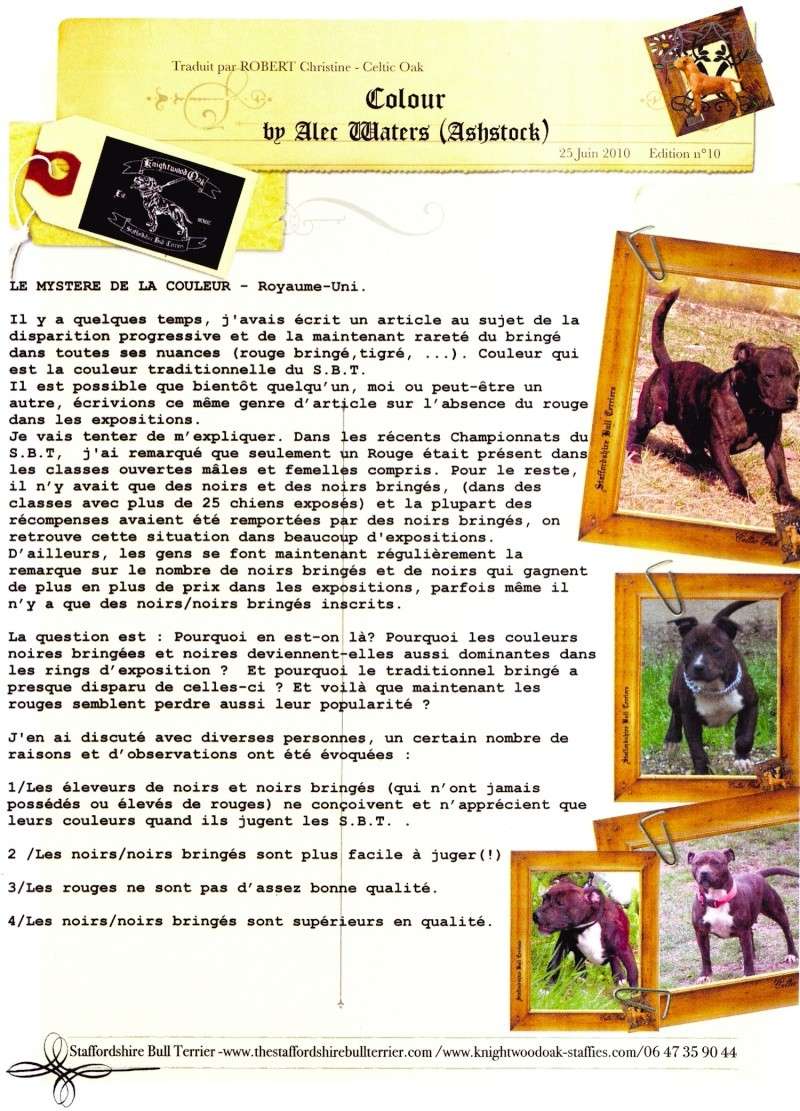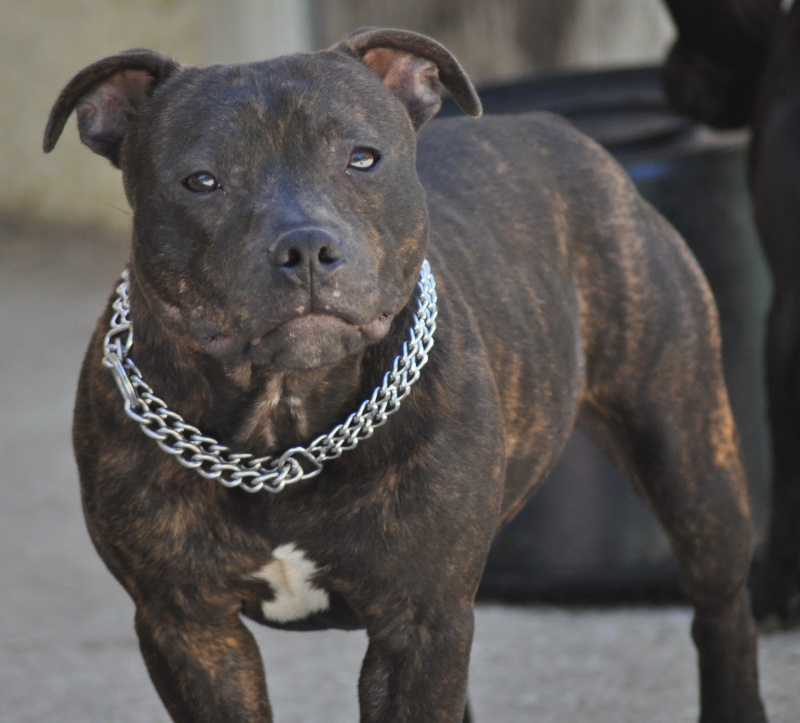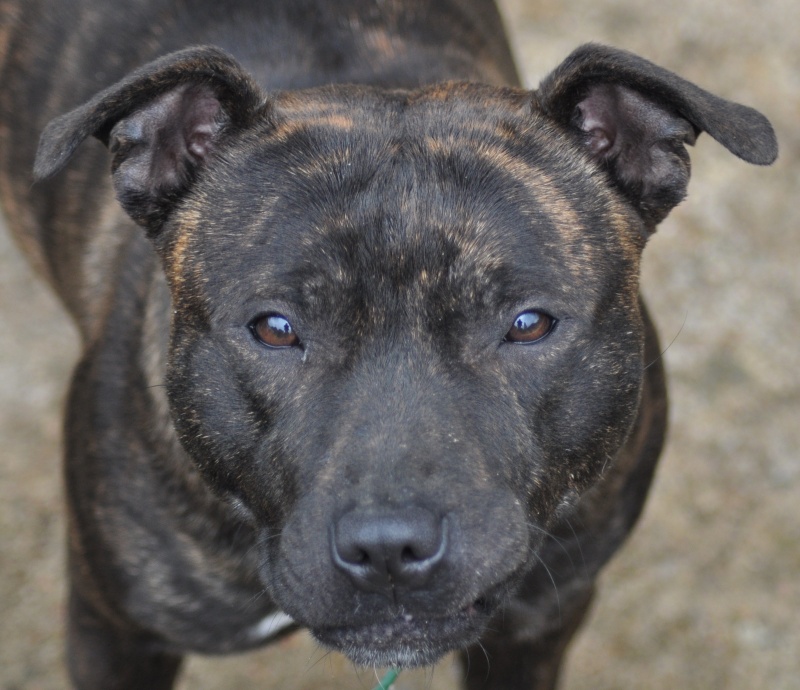L'importance de la couleur bringée dans le Staffordshire Bull Terrier
Very important to keep a good quality line of Brindle coloured staffords in a breeding programme, this being the original colour for the stafford. Brindles can be crossed into any other colour keeping the pigmentation rich, with the current mode for reds if careful attention isn't paid the rich red colour we see in the South African reds can dilute to a washed out version of 'sandy yellow' (sable) similar to that of the Labrador. The colour brindle should be looked upon as a nobel colour that as stated is the key to everything...
Brian Gilbert (Knightwood Oak)
Traduction :
Il est très important de garder une lignée de staffords bringés de bonne qualité dans un programme d'élevage, le bringé étant la couleur originale du Stafford. Ceux-ci peuvent être croisé avec n'importe quelle autre couleur et permet ainsi de garder une bonne pigmentation. Avec la mode actuelle pour les rouges, si nous ne faisons pas attention, la couleur rouge et très pigmentée que nous voyons dans les lignées sud-africaines pourrait devenir alors comme délavée ... jaune sablonneux, semblable à la couleur du Labrador. Le bringé devrait être considéré comme une couleur noble qui, comme je viens de l'exposer, est la clef de tout...

























COLOUR CONUNDRUM IN THE U.K.
Some while ago I wrote an article about the gradual disappearance, or rarity of the S.B.T. traditional colour of Brindle, that is the Brindle of varying shades, i.e. red, fawn, mahogany, tiger, and all of the different shades of these colours. It seems to me that in time I, or perhaps someone else, will be writing a similar article about the rarity or the decline of the Red, at least in the show ring.
I will endeavour to explain, at a recent S.B.T. Championship Breed Show, I noticed that only one Red was present in both the Open dog and bitch classes, the rest were black and dark brindles, (in classes of well over 25 exhibits), and most of the main awards were won by Dark Brindles, this situation is becoming common practice at many shows, in fact people now regularly comment on the number of dark and black brindles who seem to win most or many of the prizes, and, at many shows, the line up for the challenge for the Challenge Certificates, consists mainly (sometimes all of them) with dark and black brindles.
The question therefore, has to be asked, why is this, why are dark and black brindles becoming a greatly dominant force in the show ring, and why has the traditional brindle (in the showring) almost disappeared, and now the Reds seemingly losing popularity?
I have discussed this matter for some time, with various people, and a number of reasons and observations are offered, i.e.
1/ Breeders of dark or black brindles (and never ever owned or bred Reds) can only see or understand dark or black brindles
when they judge this breed.
2/Dark or black brindles are easier to assess (!)
3/ The reds are not good enough (!)
4/ The brindles are superior.
If the first two solutions are correct, then I can only reach the sad conclusions that this breed is in serious trouble!
And exhibitors who exhibit red dogs are being swindled out of their entry fees! Surely if everyone pays the same entry fees then
everyone is entitled to the same consideration, or perhaps it should be made perfectly clear to all in the schedule, that
Mr. Bloggs, (or Mrs. Bloggs) the judge, will only look at,and only place the dark and black brindles, and will ignore or disregard
the colours that he (or she) does not like or understand!
At least exhibitors with Reds would not have to waste their time and money in entering under such judges! But there can
be no doubt that such judges do exist, but the reason why these judges possess this attitude is beyond my comprehension.
The third reason I cannot except, while agreeing that there are a very large number of excellent quality Dark and Black
Brindles being exhibited, but nevertheless we have seen, at times, quality reds standing down the line behind black or
dark brindles that do not possess the same qualities as those particular Reds.
The third and fourth I cannot except, but I believe that there is some confusion about quality and quantity, the plain fact
is that the Dark and Black Brindles have become extremely popular, and that there are many more Dark and Black Brindles
bred, and not nearly so many Reds. In fact I am always being requested for Red bitches, which only proves my point that
quality red bitches are becoming hard to find, and in fact people who like Reds often wait months to obtain one.
However, we can continually speculate about the possible reasons, but if this situation continues, our breed could develop
problems of coat colour. If breeders continually breed Dark or Black Brindles to other Dark or Black Brindles the more dominate
this colour will become. Carried to extreme limits, the main or only colours of the S.B.T., in say 20 years time, will be Dark or
Black Brindle.instead of the attractive diversity of colours we have at the present.
As I have written in previous articles (which I hope that my faithful reader found interesting) there are over 30 colours and
combinations of colours in this breed, a situation that must be envied by some other breeds.
I have seen litters in the whelping box with various colours, there could be a Red, or two, a Red or Fawn Brindle, and a
variety of shades of Dark Brindles, often the result of breeding Reds to Dark Brindles or Brindles.
The most important point here is the fact that Dark Brindles will only produce Dark or Black Brindles, (if there is no red
background in either of the Sire and Dam,) and no other colour, except of course when mated to a Red, when then we
may see the variety of colours, i.e. Reds, Dark Brindles, and Traditional Brindles!
Therefore, we can clearly see the great importance of the Red colour in breeding, if we are going to keep all the various
colours, if we do not appreciate or value this colour, then there can be no doubt about the final outcome.
There are of other vital reasons in keeping our valuable diversity of colour, firstly the Pigmentation factor, (i.e. intensity
of colour, and markings, black toenails and eyerims, etc.) There can be no doubt that the mixing of colours considerably
helps to keep or improve pigmentation. Continual breeding of Red to Red, or Dark or Black Brindle to Dark or Black Brindle
will only result in the eventual deterioration of good pigmentation. I have seen poor pigmentation in all colours, because
of such breeding, the signs are all too obvious, grey noses, washed out brindles (often refered to as Blues), grey eyerims,
with ‘spectacles’, lack of hair inside the thighs, white or fawn toenails, and so on.
Another obvious reason for the mixing of colours in our breeding, is that it helps to improve or keep the correct texture of
coat, dogs from mainly Dark or Black Brindle breeding sometimes have harsh coats, mainly along their backs, whereas dogs
from mixed colour breeding usually have close coats of the desired texture.
At this juncture I would make it clear that I like and admire the Dark and Black Brindles, and had the fortune to have ‘made
up’ 3 Dark Brindle Champions, but I also like and appreciate the Reds!
Colour breeding :
The following GENERAL ( or GUIDE LINES) rules of colour breeding are as follows
Red to red produce only reds,
Red to Dark Brindle, produce reds, traditional brindles of various shades, dark brindles
Dark brindle to Dark Brindle (if one or more of the parents of the pair is red) produce,
Reds and dark brindles, and possibly red or fawn brindles.
Black brindle to black brindle, produce only black brindles
Traditional brindle (any brindle carrying red) to any kind of brindle, produce reds, various shades of brindle
White to white, produce all whites with various small markings.
It is important to note that the colour of the parents of the mating pair, play an important part in the colour of the puppies.
White to any solid colour often produces solid colours and/or pieds
ALEC WATERS (ASHSTOCK)





